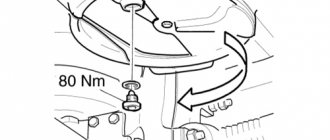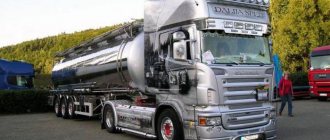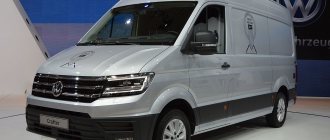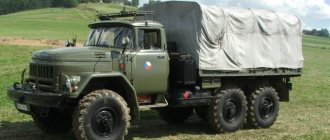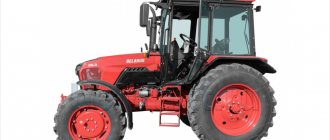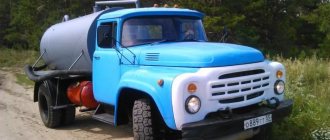Scania P380 dump truck
The Scania P380 dump truck is a special purpose vehicle that is used in industry, construction and public utilities for transporting goods in conditions of varying complexity.
For stable round-the-clock operation, the Scania dump truck has 5 types of cabs: a day cab, three different types of night cabs (with a berth) and a short cab. The cabin is equipped with an ergonomic driver's seat (heated and 10 adjustment modes) on a specially designed air suspension. A Russified BC and a convenient control panel are installed for comfortable performance of all work operations.
All contours are thoroughly verified. High-quality block headlights in the bumper are complemented by two additional headlights installed above the sun visor. Additional side lights are also installed there. Between the headlights, directly above the bumper, there is a folding platform for wiping the windshield.
A driver of average height, standing on the platform of a Scania P380 dump truck, will reach the top edge of the glass. By lifting the radiator trim, which is equipped with a lock, the driver discovers a lever for raising the cab. This arrangement of the lever prevents the possibility of breaking the lining when servicing the engine, since it is used to lift the cabin.
According to the general opinion of many drivers, the cabin has very convenient entry and exit via steps with removable rubber mats. The doors open 90 degrees and have comfortable handrails on the sides. Powerful, electrically adjustable and heated wide-angle exterior mirrors provide virtually perfect visibility.
Dump trucks, tractors 6x6 Scania YAKUTIA KHABAROVSK MAGADAN BLAGOVESHCHENSK
Dear Clients!
You can buy Scania tractors, buses, dump trucks and Scania special equipment from the official dealer in the Far East - DV Scan LLC. In order to choose a Scania tractor and make the right decision, we invite you to read reviews from owners of Scania tractors, test results and test drives in this section of our website. You can also write your review about the operation of the Scania tractor using the feedback form at the bottom of the page.
- Scania R730 tractor test - Scania R730 (2009). Comparison with MAN TGX 680
- Test of the Scania R730 6×4 road train
- Test of a tipper train for coal removal Scania P420 6×4 EHZ (46 tons)
- Test of the Scania armored tractor for the NATO army - a real explosion of the tractor
- Review of an exclusive tractor unit - Scania R730 Black Amber V8
- Test of a new series of Scania dump trucks - OFF ROAD
- Comparison of Scania, Volvo, MAN, Mercedes tractors. Scania G420 Highline test
- Scania G440 tractor test video
- Scania Streamline tractor test video
- Review of an exclusive 620 hp V8 6x6 tractor - Scania R620V8 6x6
Sale of 6x6 tractors, 6x4 tractors, dump trucks Khabarovsk
Scania reviews - review of the Scania R380 tractor
“What I really like about Scania: when it was designed, they thought very well about the drivers. The hand rests on the gearshift lever itself, the adjustment of the steering wheel and seat is rich, even the ABS works unobtrusively and correctly. “Erka” is an absolutely amazing car! The “small” Scania is also good, except that the equipment is not rich and the engine tunnel is higher, but it is still convenient to climb onto the “sleeper”.
After the tests, I met a friend: he used to drive a Volvo FH, and in August 2007 he bought a brand new Scania R380 tractor. Now the mileage is already 165 thousand km, and there are no problems: it only goes for maintenance. “The only problem was in winter - the door lock froze. One night near Omsk it was frosty, minus 42 degrees, I slept with the Webasto hair dryer turned on. In the morning I woke up and thought - that’s it, I won’t start. The glow plug worked for a couple of minutes - dum! - and the engine came to life! Scania is unpretentious, consumes any diesel fuel from normal gas stations, and the consumption is modest.”
So, if I were ten years younger and healthier, I would borrow money and buy an Erka! And I could easily “recapture” it in three years: the car instills such confidence and a sense of reliability that I am ready to drive it without hesitation, even to Novy Urengoy, or even to Krasnoyarsk.”
Dmitry Silin, private truck driver
https://trucks.autoreview.ru/archive/2009/05/scania/
Reviews Scania - ergonomics and comfort of the cab of Scania R420 and G380 tractors
“Having driven the car to the test site, I caught myself thinking that while I was rummaging through the shelves while driving, I was doing everything else intuitively: steering, braking, changing gears, looking in the rear-view mirrors, and so on. In short, I felt at home, although I had previously driven a Scania (the previous, “fourth” series) several years ago.
What does this mean? Yes, the ergonomics and organization of the internal space are simply magnificent! Moreover, again, regardless of the model and country of manufacture.
Both tractors have electric mirrors and power windows, a steering wheel with control buttons for cruise control and an on-board computer (of course, with a Russified menu), a seat with all kinds of adjustments and an integrated seat belt. Ease of entry and exit is top five, the range of adjustments for the steering wheel and seat is very wide, the passenger seat folds down into a table, and there are nets for small items on the walls - just like on a train. In addition, truckers will appreciate the number of drawers, recesses (the same ones where I was looking for a pen), cup holders and “bottle holders.”
Gennady BORISOV
https://trucks.autoreview.ru/archive/2009/05/scania/
OLYMPUS DIGITAL CAMERA
Reviews Scania - the difference between the Scania R Highline and G series cabs
“The main difference between the G and R Highline cabs is the living space. Due to the fact that the Erki cabin is mounted higher on the chassis and the roof is raised, you can stand in it at full height. Even the folding gear lever, typical for Scania, falls not forward, but backward, without interfering at all when parking. In addition, there are a lot of nice things: air conditioning, a power sunroof, large shelves above the windshield, a drawer under the bed and a radio with steering wheel controls.
The Erka even has a connector and cables for connecting to an external power supply. I connected it to it in winter and it’s amazing: the engine is always warm, and you can even install an oil radiator in the cabin for heating.
Sleeping places in Scania R and Griffin
It is also more convenient for two people to spend the night in the “erk”: it has a noticeably greater distance from the bottom to the top bunk. The difference is like between a cramped closet and a spacious bedroom! But if there is only one driver, he is comfortable in Griffin. Moreover, the night lights are located on both sides of the sleeping shelf (if you want, lie with your head to the right, if you want, lie down with your head to the left), and the control panel for the “autonomous” stove with a long cord can be reached anywhere.”
Gennady BORISOV
https://trucks.autoreview.ru/archive/2009/05/scania/
Reviews Scania - driver-friendly cabin Scania R Highline and G series
“I repeat that from a driver’s point of view I like everything here. Well, or almost everything. The ability to quickly “adjust” the steering wheel and adjust the seat (by adjusting the stiffness of the suspension and lumbar support), quickly enter the on-board computer with a clear menu in eleven languages, including Russian.
I was especially pleased with the side sun visor: it not only lowers, but also moves to the side, blocking the necessary part of the window from the light. But lowering the front visor on the “erk” while moving is more convenient (the visors themselves are made differently).
The steering wheel with buttons and the gearshift lever with well-placed divider and range flags are good. The gears are engaged clearly, the forces on the controls are adjusted, and the controllability is excellent.”
Gennady BORISOV
https://trucks.autoreview.ru/archive/2009/05/scania/
Scania reviews - fuel consumption of Scania R420 Highline and G380
“As for fuel consumption, after the test “torment”, when we pressed the gas pedals to the floor, the on-board computers showed about 31 l/100 km - we repeat, with semi-trailers, but without cargo. And when driving only tractors, both computers, as if by agreement, stated 22 l/100 km at an average speed of 42 km/h (taking into account pushing in traffic jams). It seems that the cars are quite economical even with a load.”
Gennady BORISOV
https://trucks.autoreview.ru/archive/2009/05/scania/
Scania R500 4×2 tractor for sale in Khabarovsk
Reviews Scania - operating experience. How to measure the fuel level in a Scania tank?
“The lever for raising the cab is located “correctly” here, under the rising radiator trim (this prevents it from breaking when tilting the cab), and it also serves as... a fuel gauge. Ferry drivers suggested that when diesel fuel splashes on the bottom of the tank and it is unclear from the indicator in the cabin how much is actually left, they do this. The lever consists of two parts - thick and thin. You need to lower the thin side into the tank - and if it’s all immersed in fuel, then the tractor without a semi-trailer will definitely travel at least a hundred kilometers.”
Gennady BORISOV
https://trucks.autoreview.ru/archive/2009/05/scania/
Scania R Series Cab Topline
Reviews Scania - operating experience Scania Griffin 6×4
Kazakevich A. A., General Director of Sibkriotrans LLC (Omsk): “In the summer of 2004, our company purchased the first batch of Scania trucks. These were Griffin 6x4 trucks. Over the past six months, tractors have covered more than 100 thousand km along the far from ideal roads of Siberia and Kazakhstan. There have been no comments on the design and, I hope, there will not be any. The only thing that worries me is the mounting of the rear wings. We have already welded the ill-fated bracket four times. I would like this deficiency to be eliminated on future machines.”
Yakushev A. A., head of the supply service of automobile plant No. 37 (Moscow): “Our automobile plant was one of the first in the country to receive Scania Griffin vehicles back in 2001. Since then, the fleet has been replenished with another 8 trucks, and in total today it has more than 100 units of equipment, 35 of which are Scania brands. The concept of the car is ideal for domestic transportation - an optimal package of options without frills plus traditional Swedish quality. We are very pleased with the cars.”
Bayrangulov A.A., chief dispatcher of Vladimir Management LLC (Moscow): “We operate more than 50 Scania trucks, of which 10 are Griffin family units. They work throughout the country - from Krasnoyarsk and Irkutsk to Krasnodar and Sochi. The average annual mileage is at least 200 thousand km, but the cars cope and do not let us down. Among the shortcomings, drivers note a rather weak engine, a non-adjustable steering column and a small fuel tank. It’s good that the 2005 models also featured a more powerful engine with 340 hp. s., and an adjustable steering column. As for the small tank, you can always install a second one at the company service station.”
Truck tractor Scania G400 LA4x2HNA Griffin Space
Reviews from Scania owners - reviews of Scania R500 V8
Scania trucks with V8 engines are rightly called “King of the Road”. It is no coincidence that the most powerful truck in the world is the Scania V8, with 730 hp. St. Petersburg Transport has chosen Scania V8 R500 for its fleet
Review of Scania P420 dump truck with dump trailer
Scania P420 dump truck test
Test drive Scania G440 Red Merlot
Scania G440 tractor test video
Video - test drive Scania Streamline
Scania Streamline tractor test video
Reviews of Scania R730 tractors
Scania R730 tractor test - Scania R730 (2009). Comparison with MAN TGX 680
Scania takes the quality of the interior: the plastic is downright magnificent (no match for that of the new Actros!), the table is very hard, and in addition there are cozy details like night lamps on flexible legs.
If in MAN it is more convenient when parking, then in Scania it is more convenient when driving! The seating position is close to that of a car, and you find a comfortable position very quickly. The low-set mirrors do not interfere with the view, the panel “envelops” the driver... But the MAN is more “traditionally cargo-carrying”: the seating position is not so comfortable, and you have to get used to it; the seat, despite more developed lateral support, is not so cozy.
If without a truck Scania does not drive so confidently on a snowy road, then with it it is noticeably better than MAN! You don’t have to “catch” it with the steering wheel on the road, the car is less prone to skidding...
The difference is in the steering and suspension: Scania's steering is more accurate, but the steering wheel gets jolts from small irregularities. But MAN “swallows” them, but “eats” large potholes worse. And if the Scania’s steering wheel rim is thin, then the MAN’s is even too thick.
MAN is also noisier. If there is silence in Scania (except that the instrument panel creaks on bumps), then the MAN engine does not even whistle while driving, but howls, especially during gear changes.
Of course, both “automatic machines” operate imperceptibly, without even a hint of jolts when switching: the designers taught this to the electronics. But with MAN she strives to keep the tachometer needle below the “green zone” all the time and switch to a more economical, higher gear. This in itself is good, but on a snowy slope the car may lose speed and eventually stall!
In addition, the system switches gears up and down every now and then, looking for the most suitable one. I counted: on a snow-covered turning circle with a diameter of about fifty meters, the Manov gearbox “clicked” the steps eight (I repeat, eight!) times.
“The eighth - the seventh - oh, no, the eighth again, sorry, I was wrong, after all, the seventh, no, the ninth...” What are you talking about, dear? As a result, all the way we had to manually “push” the gears with the steering column lever (fortunately the system allows this), and on a long four-percent climb we had to completely switch to manual mode in order to “lock” the selected gear. Otherwise, in the middle of an ascent, the gearbox will easily switch to a higher gear and “land” the road train!
But Scanie’s “automatic” Opticruise is much more competent and intelligent. It’s as if he sees the road and knows what you need: he switches as rarely as possible and exactly at the speed required in a given situation, requiring almost no manual intervention. On the same lap, Opticruise changed gears only three times (twice down and when exiting the lap up), and on a long climb it not only allowed it to gain momentum, but also allowed it to accelerate the tractor. As a result, where on MAN I could hardly crawl up a hill at 50 km/h, Scania easily accelerated to 65 km/h!
And here's another thing. When, while driving a MAN in automatic mode, you “push” the gear manually, the system shows on the display that it has temporarily switched to manual mode. But if at this time you try to turn this manual mode “on permanently”, the box... goes into automatic mode again.
But with Scania everything is clear: if you drive in automatic mode, it is turned on even during manual manipulations with the gearbox. And as soon as you press the button on the end of the lever, “M” lights up on the display, manual, that is, manual mode.
Here it is, the difference between a purchased gearbox (let me remind you that MAN has ZF AS-Tronic) and a self-developed one! So the future lies with systems like Scania’s: with a slope sensor (that’s why the box “sees” the profile of the road) and “learning” (the system adapts to the driving style).
Fedor Lapshin
while moving, the MAN has to be held, and very tightly, like a horse that should not be allowed to feel the slack - especially on uneven surfaces. But Scania doesn’t just allow me to relax: it seems to guess my intentions! Before turning, you slightly release the gas, and the smart automatic transmission carefully slows down the car. The Scania cabin is also much quieter, and it has better visibility - unlike the MAN, where the A-pillars and huge mirrors get in the way.
Natalia Shevtsova, administrator of Autoreview
A MAN with a semi-trailer stands worse on the road - it is possible that it is due to different tires. In addition, Manov’s “automatic machine” was constantly trying to convince me that he was smarter, and I constantly had to correct him by “tucking” the gears. Click-click, click-click... I'm already tormented!
Not only was I struggling with the winter road here, but I was also struggling with the car: I practiced all the time, “oiling” the steering wheel and pulling it out of a skid. Now I understand why, in this weather, truck drivers in such “foreigners” can barely plod along: I’m in my Merc with a manual transmission, and I shift and go faster! And if I drive at the pace that MAN imposes on me, which customer will order me?
But Scania drives a semi-trailer much more confidently and engages gears the way I would engage them myself: it seems to understand me! It’s not surprising that when I was second in Scania, I was always “breathing down” MAN’s back, and when I was first, I “ran away” from him.
It’s also more comfortable for me to sit in Scania. Dmitry Silin, private truck driver, drives a Mercedes-Benz SK1838
Scania has a more pronounced mutual understanding between the car and the driver. Thanks to the “smart” gearbox, the tractor better understands what I want from it! Apparently, its automatic transmission is tuned specifically for this engine - and allows it to operate in a wide range of revolutions without having to change gears again (although in problem areas I still switched to manual control of the transmission - it’s more reliable). And the sound insulation of the Scania engine is clearly better.
powerful engines are good, say, when transporting heavy loads in mountainous areas, and overtaking with them can be completed quickly and safely.
Nikolay Panov, international truck driver, drives a DAF CF85
"Autoreview" 2012, No. 1
- Detailed information about the Scania R730 tractor
- Test of the Scania R730 6×4 road train
Reviews from Scania G400 owners and drivers
load on rear axle, kg 30,000 Center distance, mm 3,300 Gearbox Model Model SCANIA GR905 9-speed, with 2-row range shifter for upper and lower ranges Type Final drive SCANIA RВР835 RP835 with planetary wheel reduction gears, with interaxle locking and cross-axle differentials, gear ratio 4.27 Dumping platform Unloading direction Dumping body with rear unloading Platform volume V 16 m3 Heating of the platform with heated exhaust gases and an awning folded along the side of the body Wheels and tires Wheels Front rims 11. Also in the cabin there is an independent heater dry type, 2 kW; Premium radio; tachograph Shtrikh-M; FMS telematics system with Monitoring package.
Clutch. dimensions
“I consider this the definitive proof of how Scania technologies help vehicle owners achieve maximum operational efficiency,” says Stefan Dorsky, Senior Vice President and Head of Scania Trucks. Even on little things, like KamAZ, I had 5 new KamAZ trucks so that pipes or hoses rubbed out, or something came loose, something like this never happened with Scania.
| General characteristics | |
| Wheel formula | 6×4 |
| Fuel tank capacity, l | 500 (right) |
| Engine | |
| Model | SCANIA DC12 17 380 direct injection diesel engine with turbocharging and intermediate air cooling |
| Number of cylinders / Location | 6 / in-line |
| Maximum power, kW/hp (at rotational speed, rpm) | at 1900 min-1: 280 (380) |
| Working volume, l | 12 |
| Environmental standard | EURO 3 |
| Cooling system | liquid cooling |
| Brake system | |
| Brake type | Double-circuit system, fully pneumatic, direct acting |
| ABS | Anti-lock braking system (ABS), brake force adjustment valve depending on the load, parking brakes on the front and rear axles, automatic engine brake, air dryer. |
| Suspension | Front suspension: parabolic springs 4x28, rear suspension: parabolic springs 5x48/90 |
| Cabin | |
| Type | Above the engine, 2-seater |
| Heater | There is |
| Air conditioner | There is |
| Electric windows | There is |
| Electric mirrors | There is |
| Electrically heated mirrors | There is |
| Radio tape recorder | There is |
| Luke | There is |
| Cruise control | There is |
| Tachograph | There is |
| Execution | with sleeping place |
| Weight characteristics | |
| Permissible load capacity, kg | 24 000 |
| Max. front axle load, kg | 9 000 |
| Max. rear axle load, kg | 30 000 |
| Center distance, mm | 3 300 |
| Transmission | |
| Model | Model: SCANIA GR905 9-speed, with 2-row range shifter for upper and lower range gears |
| Type | Final drive: SCANIA RВР835/RP835 with planetary wheel reduction gears, with inter-axle and cross-axle differential locks, gear ratio: 4.27 |
| Tipper platform | |
| Unloading direction | Dump body with rear unloading |
| Platform volume | V=16m3 |
| Platform heating | heated by exhaust gases and an awning folded along the side of the body |
| Wheels and tires | |
| Wheels | Disks: front — 11.75/22.5″, stamped steel, 3 pcs., including spare wheel, rear — 9.00/22.5″, stamped steel, 8 pcs. |
| Tire size | Tires: front - 385/65R22.5 (3 pcs.) rear - 315/80R22.5 (8 pcs.) |
Qн = 0.01 x (Hsan x S + Hw x W) x (1 + 0.01 x D)
where Qн is the standard fuel consumption of a Scania van, l; S —van mileage, km; Hsan - fuel consumption rate for the van's mileage in running order without cargo;
For Scania vans operating without taking into account the weight of the cargo being transported, the normalized value of fuel consumption is determined taking into account an increasing correction factor - up to 10% of the base standard.
| Scania vans from 2008 | |||
| Model, brand, modification of the car | Engine power, hp | Working volume, l | Fuel consumption rate, l/100 km |
| 1 | 2 | 3 | 4 |
| Scania P230LB4x2HNA | 230 | 8,867 | 24.9D |
| Scania P340L6x2HNA | 340 | 10,64 | 26.1D |
Scania fuel consumption rates are necessary for the work of ATP and organizations related to the vehicle management and control system, individual entrepreneurs (IEs) using automotive equipment and special rolling stock on chassis on Scania buses, calculating the standard value of Scania fuel consumption rates at the place of consumption, for maintaining statistical and economic reporting.
Cost of the Scania G400 car on the Russian market • Services for the driver
| Scania R420 technical specifications and payload, engine and fuel consumption This allows him to use his in-depth knowledge of product specifications to meet customer needs and expectations. For example, diesel engines of different volume and design are largely unified among themselves in terms of piston, separate heads, connecting rods and crankshaft liners. |
| View topic - Scania G380 HPI 2011 - increased consumption 42 l/100 km And it is remarkable that the Scania winners in this and other tests belong to the same category of trucks that are used in everyday activities. EcoRoll Active Prediction uses GPS to predict road surfaces and select gears and speeds before ascending or descending, and determines when descending in neutral will provide maximum fuel economy. |
- adjustable high and low beam headlights;
- anti-fog headlight;
- rear lights.
Fuel efficiency is never rushed • Over the course of a workday, this system has been proven to provide up to 2 percent fuel savings with less than two minutes of lost time.
Qn = 0.01 x Hs x S x (1 + 0.01 x D) + Hot x T, (2)
where Qн is the Scania fuel consumption rate, l; Hs is the transport fuel consumption rate for the mileage of a Scania bus, l/100 km (taking into account the passenger load normalized by class and purpose of the bus); S —bus mileage, km; Hoth - fuel consumption rate when using standard independent heaters for the operation of the heater (heaters), l/h; T — operating time of a Scania bus with the heater on, h; D — correction factor (total relative increase or decrease) to the norm, %.
| Scania buses from 2008 | |||
| Model | Engine power, hp | Working volume, l | Fuel consumption rate, l/100 km |
| 1 | 2 | 3 | 4 |
Fuel consumption Scania P340 with Load
Time zone: UTC + 4 hours [Summer Time]
The headline of the message:
Scania G380 HPI 2011 - increased consumption 42 l/100 km
Added:
Sun Nov 26, 2022 7:24 am
Dear Colleagues! Scania G380 HPI 2011 consumption 42 l/100 km. New piston, new injectors, new actuators, catalyst removed, urea switched off in SOPS, boost pump 16 atm normal, pulls well, same driver on a different head with the same trailer 29 l/100 km. Tell me what else to do to equalize the consumption to about 29 l/100 km? Who to contact ?
The headline of the message:
Re: Increased fuel consumption
Added:
Sun Nov 26, 2022 10:52 am
Is the side of the car black? If not, put another driver in this car and it’s better to go on the same trip with him. And you will rule out your suspicions and the picture will become clearer
The headline of the message:
Re: Scania G380 HPI 2011 - increased consumption 42 l/100 km
Added:
Sun Nov 26, 2022 3:52 pm technix wrote: the catalyst has been removed, and what has been replaced?
What does the inflation pressure indicate? Message title:
Re: Scania G380 HPI 2011 - increased consumption 42 l/100 km
Added:
Sun Nov 26, 2022 4:20 pm Is the engine filter clogged?
Message title:
Re: Scania G380 HPI 2011 - increased consumption 42 l/100 km
Added:
Mon Nov 27, 2022 12:08 am Look at the miner's damper.
Message title:
Re: Scania G380 HPI 2011 - increased consumption 42 l/100 km
Added:
Mon Nov 27, 2022 7:28 am
Already 3 drivers have changed, 42 l/100 km is the minimum that we got, and tied and untied. About a dozen filters have already been changed. The inflation pressure and temperature were checked - normal.
The headline of the message:
Re: Scania G380 HPI 2011 - increased consumption 42 l/100 km
Added:
Mon Nov 27, 2022 10:00 am
There are no miracles! Somewhere, something is wrong. Add other injectors. Just don't say they're new.
The headline of the message:
Re: Scania G380 HPI 2011 - increased consumption 42 l/100 km
Added:
Mon Nov 27, 2022 10:01 am Or take it to another service.
Maybe they don’t see something in this? Post subject:
Re: Scania G380 HPI 2011 - increased consumption 42 l/100 km
Added:
Mon Nov 27, 2022 10:22 am
Above there was an offer to take a ride with a driver. The result will be immediately visible. Either the car or the driver is at fault.
The headline of the message:
Re: Scania G380 HPI 2011 - increased consumption 42 l/100 km
Added:
Mon Nov 27, 2022 11:37 am How can you find out the VIN of a car?
Message title:
Re: Scania G380 HPI 2011 - increased consumption 42 l/100 km
Added:
Mon Nov 27, 2022 1:26 pm
I rode with the driver in different cars on trips of 3000 km. Accordingly, one has 29 liters. on the other 42 l. And I looked at the driving scores on the dashboard, and turned on the green scale on the tachograph. VIN xxx5278009. Injectors from Belgium were received through OmskScan, tested on a bench, ideal - no effect on consumption. Official dealers in Novosibirsk, Irkutsk, Omsk also had this problem, and unofficial ones too. All recommendations were followed. I don’t know what to change anymore. Consumption was measured by checking at a gas station and the tank was consumed to zero, and according to the computer - the same.
The headline of the message:
Re: Scania G380 HPI 2011 - increased consumption 42 l/100 km
Added:
Mon Nov 27, 2022 1:45 pm den_2001 wrote:
Is the side of the car black? If not, put another driver in this car and it’s better to go on the same trip with him. And you will rule out your suspicions and the picture will become clearer
Qн = 0.01 x (Hsan x S + Hw x W) x (1 + 0.01 x D)
where Qн is Scania’s standard fuel consumption per 100 km, l; S —mileage of a car or road train, km; Hsan - fuel consumption rate per mileage of a Scania vehicle or road train in running order without load;
| Scania trucks from 2008 | ||||
| Model, brand, modification of the car | Engine power, hp | Working volume, l | checkpoint | Fuel consumption rate, l/100 km |
| 1 | 2 | 3 | 4 | 5 |
Device
The car has a 1940 mm gap between the front and second axles, another 4700 mm between the second and third axles, and 1445 mm at the base of the rear bogie. In case of refusal or evasion of the winner of the auction or subsequent bidders who submitted an application during the same period of validity of the offer price from signing the purchase and sale agreement within 5 days from the date of receipt of the proposal of the financial manager to conclude such an agreement, as well as the absence of full payment under the purchase agreement, sale within 30 days from the date of conclusion of the contract, the deposit paid is not returned and further sales are made starting from the last price set on the day the winner of the auction is determined.
Specifications. dimensions
| Scania R440 technical characteristics According to the analytical agency Autostat, currently the number of Scania R series highways in the Russian Federation has exceeded 30 thousand vehicles. For example, on a 5-cylinder DC9 the piston stroke is 140 mm, on a 6-cylinder DC13 it is 160 mm, which, with a single cylinder diameter of 130 mm, gives in the first case 9.3 liters of working volume, and in the second 12.7 liters. |
Frame, suspension and chassis • Its cost is quite high even for large transport organizations, not to mention ordinary carrier entrepreneurs.
Born to Ride
The truck is equipped with a modern progressive hydraulic power steering system.
The brake system of the Scania R440 tractor is equipped with electronic control (EBS) and an anti-lock braking system as standard. The brake mechanisms are disc (on newer cars) and drum type (on cars of previous years of production). Parking brake control lever – with test position. The Scania R 410 tractor unit received the Green Truck 2022 award as the most economical and environmentally friendly commercial vehicle in its class. This is the fifth consecutive victory for Scania trucks in the ranking organized by the German trade publications Verkehrs-Rundschau and Trucker.
Green Truck 2022 is a competition that over the years has become something of a world championship in the transport efficiency of long-haul tractors. Tests are carried out under strict control. This test was no less intense than in previous years. Trucks up to 430 hp took part in it. with a gross weight of up to 32 tons, which covered 342.8 km on public roads mixed between highways and rural roads with difficult sections and steep hills north of Munich. All vehicles were equipped with tires of the same brand with the same wear and pressure.
Scania R 410 outperformed its competitors thanks to the following indicators:
- lowest average fuel consumption - 23.53 liters per 100 km;
- the highest average speed is 80.60 km/h over the test distance.
“Winning this test five years in a row is a feat that is impossible, but we still managed it. “I consider this the definitive proof of how Scania technologies help vehicle owners achieve maximum operating efficiency,” says Stefan Dorsky
, Senior Vice President and Head of Scania Trucks. “The ability to offer the most efficient trucks is what we always strive for. It is also critical to combating climate change and achieving our science-based decarbonization targets. While electrification is well underway, we need efficient internal combustion engines to achieve the goals of the Paris Agreement.”
Scania considers press tests to be a very important factor in the development of new technologies. This also makes a big difference to potential truck buyers, since the ratings provided by independent journalists are actually the most up-to-date consumer information available in the market.
“Some may think that tractors are specifically built for this type of competition, but that is not the case,” explains Dorsky. — This is ordinary serial equipment, the same as our clients. And it’s great that Scania’s winners in this and other tests belong to the same category of trucks that are used in everyday activities.”
After the competition, the winning trucks get a second life as test vehicles for Scania's R&D centers in Södertälje - the winners have no pension, no matter how well-deserved it is.
For more information, contact the marketing department of Scania-Rus LLC:
Standard value of fuel consumption. Foreign tractors
We continue to create calculators upon request to calculate fuel consumption for.... Let me remind you that the first calculator is the standard value of fuel consumption. Buses of domestic and CIS countries, the second calculator - Standard value of fuel consumption. Tractor units, domestic and CIS countries
In order to reawaken interest in this topic, another request was needed - calculation of fuel consumption for foreign tractors. So, the third calculator calculates the standard fuel consumption value for foreign tractors.
Since the methodological recommendations for calculations set out in the order of the Ministry of Transport of the Russian Federation dated March 14, 2008 N AM-23-r are the same for both domestic and foreign tractors, I will not repeat them here. Those who want to study the theory should look at the standard fuel consumption calculator. Tractor units domestic and CIS countries.
As in the previous calculator, for unclear parameters, when you hover over them with the mouse, an explanation pops up, such as, for example, for the parameter “Working at a reduced average speed.”
The maximum coefficients from the recommendations are taken, and only those that, in my opinion, can be applied to tractors are used. So comments and suggestions are welcome.
Calculation of standard fuel consumption. Foreign tractors
Operation of vehicles in winter
Work in mountainous areas
Operation of vehicles on public roads with a complex layout (outside cities and suburban areas), where on average there are more than five curves (turns) with a radius of less than 40 m per 1 km (or about 500 per 100 km)
When working in extreme climatic and difficult road conditions during seasonal thaw, snow or sand drifts, heavy snowfall and ice, floods and other natural disasters
Transportation of non-standard, large-sized, heavy, dangerous goods, cargo in glass, etc., movement in convoys and accompanied, and other similar cases
Work in quarries, when moving across the field, when removing timber, etc. on horizontal sections of roads of categories IV and V
Idle with engine running, hours
Work on public roads of categories I, II and III outside the suburban area on flat, slightly hilly terrain (altitude up to 300 m above sea level)
Decimal places: 1
Basic fuel consumption rate for tractor mileage, l/100 km
Fuel consumption rate for transport work, l/100 ton-kilometers
Fuel consumption rate for tractor mileage in running order without load, l/100km
Volume of transport work, ton-kilometers
Correction factor, %
Consumption due to idle time with the engine running, l
Standard fuel consumption, l
Winter period for the specified region
Fuel consumption for transport work, l
From raw steel to finished part © Performance characteristics
| 23.53 liters per 100 km - Scania tractors have been recognized as the most economical and environmentally friendly trucks for the fifth time in a row | Scania Russia The EcoRoll active forecasting system uses GPS to predict the terrain of the road and selects a gear and speed before ascending or descending, and also determines when descending in neutral will provide maximum fuel economy. The real operational mileage, the level of which is directly related to the mode of use of the technical means to perform functional tasks, also plays a major role in the price of equipment. |
- News & Events
- Corporate publications
- Articles
- Career at Scania
- Souvenir products
- About Us
- Scania events in Russia
Scania
Scania OmniExpress LK310IB (tourist 49 seats)3108.86728.5DScania OmniExpress LK310TB (monthly 50 seats)3108.86723.7DScania OmniExpress LK340EB (monthly 53 seats)34011.70525.5DScania OmniLine IK95IB (led. 50 seats) 3108.86727.6DScania OmniLine IK95IB (51 seats)2698.86733.7DScania OmniLine IL94IB 4×2/300 (52 seats)3008.97429.1DScania OmniLink CK95UB (122 seats)2308.86741.1DS cania OmniLink CL94UB (driver 39 seats)2308.86734.7DScania OmniLink SK950 B (driver 84 seats)2308.86736.9DFuel consumption for Scania trucks and road trains in accordance with the fuel consumption standard per 100 km is calculated using the formula:
